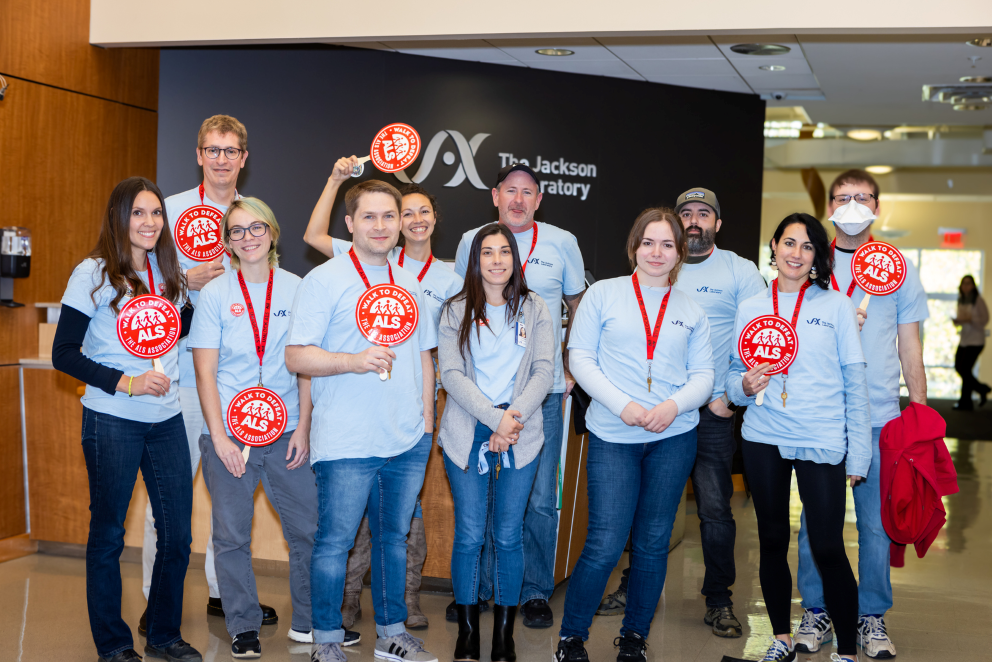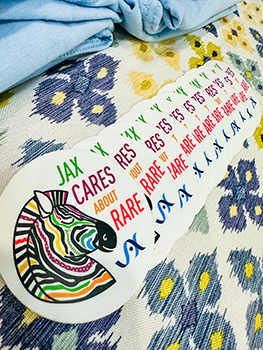 Photo credit: Tiffany Laufer
Photo credit: Tiffany Laufer
Side by side
Members of the Rare Disease Translational Center and Bar Harbor Preclinical Services participated in a walk to raise awareness for amyotrophic lateral sclerosis, also known as Lou Gehrig’s disease or motor neuron disease, a rare progressive neurodegenerative disease that affects the nerve cells necessary for motor function. Most ALS patients lose their ability to speak, eat, drink, move and eventually breathe as the brain’s ability to initiate and control muscle movement degrades over time. Despite good amounts of funds and awareness being raised for ALS from events such as this and the 2014 ice bucket challenge, successful treatments have yet to reach the market.
Highs and lows
The ALS community has been through a roller coaster of highs and lows over the past two years. In August 2022 BrainStorm-Cell Therapeutics announced its work on NurOwn, an investigational cell-based therapy. In a method similar to how immunotherapies are created, NurOwn treats patients using their own mesenchymal stem cells. The MSCs are removed and grown in a laboratory where they are converted into cells that produce a large amount of signaling molecules, to promote nerve cell growth. Once these cells are mature, they are injected back into the patient’s spinal canal, where they are effective in secreting the high levels of neurotrophic factors needed to improve ALS survival. BrainStorm submitted its Biologics License Application to the FDA for approval of the therapy, but unfortunately the collected data did not indicate a statistically significant improvement to patient outcomes compared to the placebo group. The FDA is set to decide NurOwn’s fate in December 2023. While it is predicted that the FDA will reject NurOwn, all is not completely lost. The study provided both research and pharmaceutical companies with a better understanding of how to design clinical trials, and it identified potential biomarkers for future therapies.
Hope on the horizon
While ALS patients, caregivers and providers wait for December, another potential therapy has entered the scene. Tofersen (also known by its pharmaceutical name Qalsody) is intrinsically different from NurOwn as it is based on antisense oligonucleotides. ASOs are short, single-stranded deoxyribonucleotides (essentially, segments of DNA) that are specifically designed to bind to molecules of RNA produced by SOD1, a gene that, when mutated, can yield proteins that cause motor neuron degradation. The original preclinical proof of concept for a SOD1 binding ASO (McCampbell et al., 2018) was established in rodent models of SOD1-ALS, including the SOD1-G93A ALS model (Stock#004435) from The Jackson Laboratory. In April 2023, the FDA granted tofersen accelerated approval after being presented with data showing a significant drop in a new ALS biomarker, neurofilament light (NfL). NfL acts as a scaffold protein expressed uniquely by neurons. As neurons die off, NfL sheds into the bloodstream and is actively being used in the clinic to determine ALS prognosis.

Although tofersen did not meet its primary endpoint to receive initial FDA approval, its review period has been extended thanks to the unprecedented observation of reduced SOD1 protein. The protein is found in cerebral spinal fluid and is a known early contributor to skeletal muscle cell degradation among ALS patients with disease-causing variants in SOD1. SOD1-ALS cases represent the second-most-common cause of familial ALS, accounting for 10–20% of cases and contributing to 1–2% of sporadic ALS cases. Patients in this initial tofersen trial showed a reduction of SOD1 protein by 35%. In addition to this tremendous SOD1 finding, participants receiving tofersen also experienced NfL reduction by 50%, indicating a decline in neuron death. Overall, collective data from this trial and open label extension suggest that early tofersen administration slows respiratory and muscular decline, improving patient quality of life.
The success of tofersen has kickstarted more rounds of investigative study. A separate phase 3 trial is currently underway specifically enrolling patients with known SOD1 variations but not yet presenting with ALS symptoms. Set to complete in 2027, this trial aims to determine if tofersen can delay disease onset entirely. This is the first time a potential preventative treatment for ALS has held so much promise.
Committed to the cure
While a genetic treatment is a huge win for the ALS community, it leaves much to be done to help others not affected by SOD1 aberrations. As vice president of the RDTC, Cat Lutz, Ph.D., MBA, has dedicated much of her research to developing precise genetic mouse models of ALS, and she remains steadfast in her endeavors to keep ALS research moving forward. Having NfL as a new ALS biomarker has changed the game for RDTC projects. Currently, it is being used in preclinical rare disease models of ALS, as well as other rare neurodegenerative diseases, serving as a quantitative in-life readout. This means that the data collected by the RDTC is more clinically relevant than ever before, as it is utilizing the same biomarker assay as that being used in the clinic for ALS patients today.
Lutz’s team, which includes Markus Terrey, Ph.D., and Jennifer SanMiguel, Ph.D., is concurrently working with groups to test ASO compounds, similar to tofersen, for other rare and devastating diseases. Among those ASOs being tested, Lutz and her team are curating preclinical data for two ultra-rare diseases. The first is alternating hemiplegia of childhood (AHC), a neurological disorder causing life-threatening seizures or paralysis, in partnership with Hope for Annabel and CureAHC. The second is HNRNPH2, a developmental delay disorder leading to intellectual disability, motor and language delays, behavioral and psychiatric disorders and growth abnormalities, in partnership with Everlum Bio and To Cure a Rose.
“ASOs hold so much promise for the rare disease community,” says Terrey. “As a research team, we are hoping to illuminate the path toward a better future for these patients. We love having patients and their families with us every step of the way—it’s not just rewarding, it’s inspiring progress together.”
The tofersen clinical trials have paved the way for researchers like Lutz to closely partner with members of the rare disease community, ensuring that their preclinical data provides a solid foundation for success with the FDA. Within JAX, a dedication to enhancing lives and discovering groundbreaking solutions for individuals impacted by rare diseases is evident. Despite many hurdles, the journey toward effective treatments and ultimately a cure for ALS continues, buoyed by the unwavering spirit of those at the RDTC.
The JAX RDTC’s mission is to empower rare disease solutions through partnering, innovation, precision engineering and the scaled preclinical pipelines necessary to bring targeted therapies from lab to clinic swiftly and effectively. Learn more about partnership opportunities with the Center here.